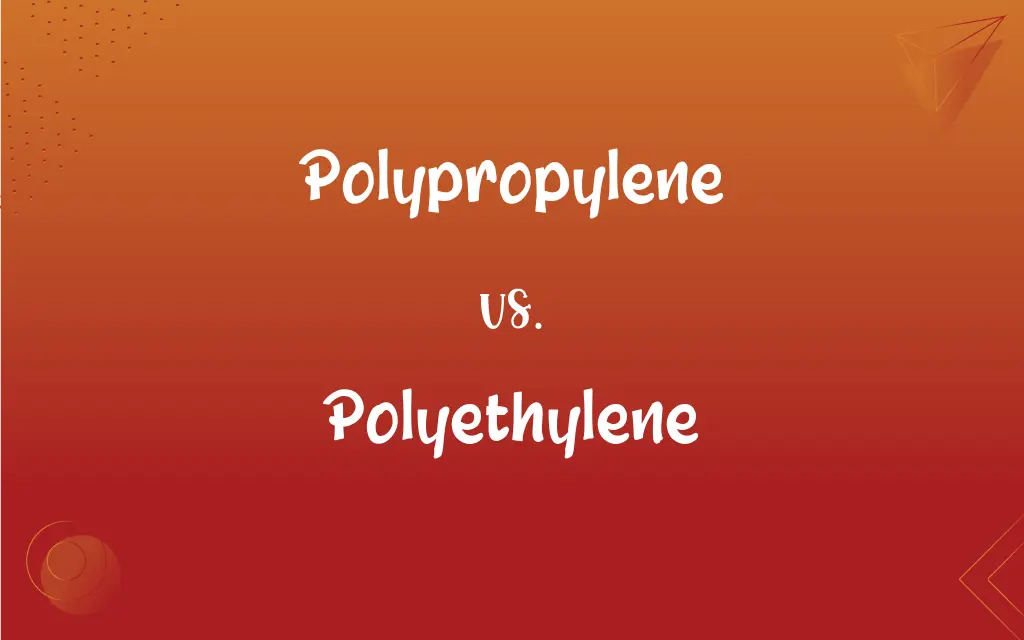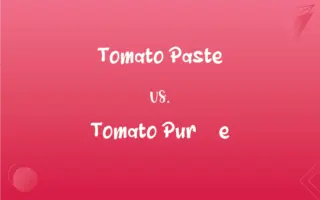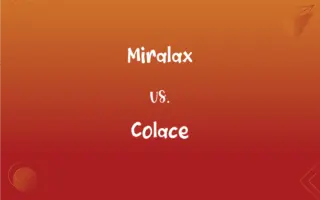Polypropylene vs. Polyethylene: What's the Difference?
Edited by Janet White || By Harlon Moss || Updated on October 7, 2023
Polypropylene (PP) is a thermoplastic polymer known for high melting point and stiffness, while polyethylene (PE) is renowned for its flexibility and is widely used in packaging due to its lightweight and durability.

Key Differences
Polypropylene and polyethylene are both polymers that see widespread usage in various industries due to their versatile properties. Polypropylene, abbreviated as PP, is renowned for its resistance to chemical corrosion and its high melting point, which makes it suitable for applications that involve high-temperature processes. Conversely, polyethylene, or PE, is celebrated for its flexibility and is commonly used in applications like plastic bags and films due to its ability to withstand significant flexing without wear.
In the realm of structural integrity and rigidity, polypropylene stands out with a stiffer constitution, providing a robust material choice for products like plastic hinges and fibers used in ropes and carpets. Polyethylene, on the other hand, tends to be more flexible and is often selected for applications where a certain degree of pliability is required, such as plastic bags and squeezable bottles. The difference in rigidity between polypropylene and polyethylene can often guide the selection process for manufacturers based on application needs.
When focusing on chemical resistance, polypropylene often slightly edges out polyethylene in its ability to withstand various chemicals, making it a frequent pick for containers and pipelines that transport aggressive chemicals. Polyethylene does still possess a commendable level of chemical resistance and is utilized in numerous applications requiring stability against different compounds, but polypropylene’s enhanced resistance often positions it as the go-to for more demanding chemical contexts.
In the world of consumer goods and packaging, both polypropylene and polyethylene find their niches due to their respective properties. Polypropylene is often employed in food packaging, medical equipment, and automotive components due to its toughness and ability to act as a barrier to moisture, grease, and chemicals. Polyethylene, due to its flexibility and lightweight nature, is prominently found in various packaging applications, like stretch wrap, and consumer goods like toys and grocery bags.
Examining the environmental impact, polypropylene and polyethylene share the common challenge of being persistent in the environment due to their resistance to biodegradation. Polyethylene, especially in the form of Low-Density Polyethylene (LDPE), has established recycling streams in many areas, making its recycle rate comparatively higher. Polypropylene, though also recyclable, may have less widespread recycling availability and may be more commonly found in waste streams. Both polymers signify the balance that must be navigated between utility and environmental stewardship in material selection.
ADVERTISEMENT
Comparison Chart
Chemical Structure
C3H6 n
(C2H4) n
Melting Point
Higher, around 160°C
Lower, between 115-135°C
Flexibility and Rigidity
Rigid and resistant to flexing
Flexible and less rigid
Transparency
Often opaque
Can be translucent
Usage
Ropes, automotive parts
Plastic bags, bottles
ADVERTISEMENT
Polypropylene and Polyethylene Definitions
Polypropylene
A thermoplastic polymer utilized in various industries.
The automotive industry uses polypropylene in the manufacturing of car bumpers.
Polyethylene
A lightweight, flexible plastic widely used in packaging.
Polyethylene is commonly used to make disposable shopping bags.
Polypropylene
A durable polymer resistant to chemical solvents.
Polypropylene is often chosen for containers that store chemical products due to its resistance.
Polyethylene
A material commonly used in the production of plastic bottles.
Milk jugs made of polyethylene are recyclable and lightweight.
Polypropylene
An inherently hingeable plastic utilized for living-hinge applications.
Polypropylene is widely used in flip-top bottles because of its living-hinge capabilities.
Polyethylene
A plastic with excellent chemical resistance.
Polyethylene tanks are often utilized to store various types of chemicals.
Polypropylene
A plastic material commonly used in textiles.
Polypropylene is a popular choice for making reusable grocery bags due to its strength.
Polyethylene
A versatile polymer employed in piping systems.
Polyethylene pipes are favored in the gas distribution industry due to their corrosion resistance.
Polypropylene
A suitable material for food packaging applications.
Microwave-safe containers are often made of polypropylene due to its high melting point.
Polyethylene
A polymer used for insulation in electric cables.
Polyethylene provides electrical insulation and protects the integrity of electrical cables.
Polypropylene
Any of various thermoplastic polymers of propylene. They are hard and tough, and are used to make molded articles and fibers.
Polyethylene
A polymerized thermoplastic ethylene resin, used especially for containers, kitchenware, and tubing, or in the form of films and sheets for packaging.
Polypropylene
A fabric of fibers made from any of these polymers.
Polyethylene
(organic compound) A polymer consisting of many ethylene monomers bonded together; used for kitchenware, containers etc.
Polypropylene
A thermoplastic resin made by the polymerization of propylene, and used for films, fibres, or moulding materials. Also known as polypropene.
Polyethylene
A lightweight thermoplastic; used especially in packaging and insulation
Polypropylene
A polymer of propylene used as a thermoplastic molding material
FAQs
Is polyethylene safe for food storage?
Yes, polyethylene is commonly used for food storage due to its chemical resistance and FDA approval for food contact.
Can both polypropylene and polyethylene be used in high-temperature environments?
Polypropylene generally has a higher melting point than polyethylene, making it more suitable for high-temperature applications.
What are common applications of polypropylene?
Polypropylene is widely used in packaging, textiles, automotive parts, and reusable containers.
Which polymer is more environmentally friendly, polypropylene or polyethylene?
Both have environmental concerns, but polyethylene is often recycled more due to its widespread use in packaging.
Which material, polypropylene or polyethylene, is more resistant to chemicals?
Both are resistant, but polypropylene often has a slightly higher chemical resistance.
Can polyethylene be utilized for making toys?
Yes, polyethylene is often used for toys due to its lightweight, moldability, and safety.
How are polypropylene and polyethylene disposed of or recycled?
Both can be recycled in specific recycling streams, though systems and capacities may vary by location.
What affects the cost of polypropylene and polyethylene?
Factors like raw material prices, demand-supply dynamics, and production costs influence the prices of both polymers.
Are there biodegradable alternatives to polyethylene and polypropylene?
Yes, there are various biodegradable plastics available, like PLA, which are derived from renewable resources like corn starch.
Which is more rigid: polypropylene or polyethylene?
Polypropylene tends to be more rigid and resistant to flexing compared to polyethylene.
What are the common forms of polypropylene available in the market?
Polypropylene can be available in various forms like homopolymers, copolymers, and impact copolymers, tailored for specific applications.
What are the common manufacturing methods for polyethylene?
Common methods include blow molding, injection molding, and extrusion for polyethylene.
Can polypropylene be used in food packaging?
Absolutely, polypropylene is widely used in food packaging as it’s safe and resistant to chemicals.
Why is polyethylene used in cable insulation?
Polyethylene is used for its electrical insulating properties and its ability to protect cables from damage.
Is polypropylene safe for microwave use?
Generally yes, polypropylene is often used for microwave-safe containers due to its high melting point.
Can polypropylene be used in the textile industry?
Yes, polypropylene is often utilized for producing various textiles, ropes, and carpets due to its durability.
Can polyethylene be used in the medical field?
Yes, polyethylene is used in various medical applications like tubing and containers due to its chemical stability and biocompatibility.
Are polyethylene and polypropylene considered biodegradable?
Typically, no. Both polymers are not biodegradable and persist in the environment unless recycled.
Which polymer is typically more transparent?
Polyethylene can be more translucent, while polypropylene is often more opaque.
Is polyethylene used in the production of pipes?
Yes, polyethylene is widely used for creating pipes due to its flexibility and chemical resistance.
About Author
Written by
Harlon MossHarlon is a seasoned quality moderator and accomplished content writer for Difference Wiki. An alumnus of the prestigious University of California, he earned his degree in Computer Science. Leveraging his academic background, Harlon brings a meticulous and informed perspective to his work, ensuring content accuracy and excellence.
Edited by
Janet WhiteJanet White has been an esteemed writer and blogger for Difference Wiki. Holding a Master's degree in Science and Medical Journalism from the prestigious Boston University, she has consistently demonstrated her expertise and passion for her field. When she's not immersed in her work, Janet relishes her time exercising, delving into a good book, and cherishing moments with friends and family.































































